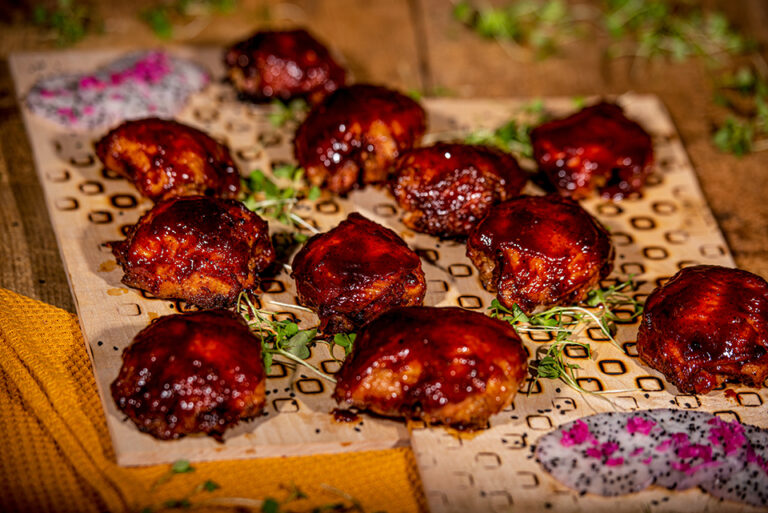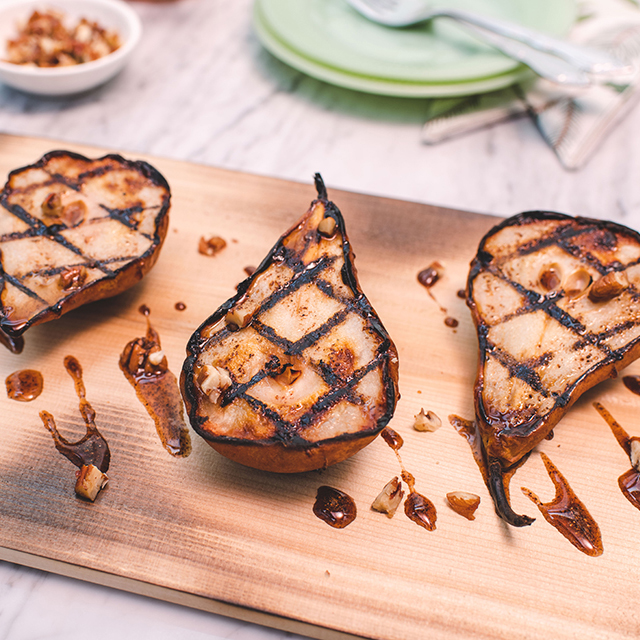Technique | Grilling Planks

Everyone loves the intense woodsy aroma that a pellet smoker grill can impart to your food. The smoke can elevate your food and create unique combinations of flavours. But what if you’re cooking on a gas or charcoal grill? Is there a way to capture that same essence in your barbecued food? There are a few different methods to do this, but an effective one is cooking with wood planks.
Using planks to grill offer a few key benefits, besides what they can do for flavour. Let’s look at how wood planks work on the grill, tips for cooking with a plank, and some good recipes to try at home.
How grilling planks work
What happens when you cook with a wood plank? Well, the obvious answer is it burns. It is wood, and when introduced to an intense heat source, it will smoulder and burn. Remember, flames do not need to make contact with wood to light it on fire. Radiant heat is often enough, which you’ll need to master with planks. The smoke from this process is introduced to the food on its surface and can make for an intense flavour. It can be even more pronounced than what you might get from a pellet smoker since the food is in direct contact with the burning material.
There is another benefit of cooking with a wood plank, and that is it helps to create a barrier or baffle between your food and the heat source. This will prevent your food from charring on the bottom and is especially useful for longer cooks and delicate items. The flame cannot hit your food directly, so the plank shields and chars instead of your meal as it gives us the smoky flavour we love.
How to use grilling planks
How do you cook with a wood plank? Well, there are two different methods depending on how quickly you want the plank to burn. If you’re cooking something hot and fast, like a planked fish, you can place your food directly on the plank with little prep, then put the plank directly on the grill surface. It will start to smoulder quickly and should only take 30-60 minutes to cook.
If you’re grilling hot and fast, follow these steps:
- Soak the plank if you like; however, this is not mandatory (read more below).
- Prep the plank surface by rinsing with water and oiling one side of the plank to prevent food from sticking.
- Preheat your grill to medium-high heat using all the burners.
- Prep your food on the plank, then place it directly on the grill.
- If wet, the wood will dry quickly within 10 minutes and move toward its combustion temperature.
- As the wood nears its combustion temperature (which for cedar is 354˚C (669˚F), it will start to smoke.
- As the smoke intensifies, cut back on the heat from the main burner below the plank or turn it off completely.
- Cycle the main burner below the plank on and off to start and stop the plank smoke over the length of your cook.
If you’re cooking something over a longer period, say a rack of ribs, your cooking method needs to change slightly. You’ll need to do some fire management to get the plank smoking but prevent it from going up in flames. Remember, when you cook low and slow, there is not enough heat at the grill surface to get the plank to start smouldering. You’ll need to crank up the heat for a short time to kick it off.
If you’re grilling low and slow, follow these steps:
- Soak the plank if you like; however, this is not mandatory (read more below).
- Prep the plank surface by rinsing with water and oiling one side of the plank to prevent food from sticking.
- Preheat your grill to low-medium heat using all the burners.
- Prep your food on the plank, then place it directly on the grill.
- If wet, the wood will dry quickly within 10 minutes and move toward its combustion temperature.
- At low temperatures, the plank will not reach a combustion point. If you intend to use it for decoration only no need to proceed any further.
- If you want the plank to smoke near the start or end of the cookout, crank up the heat to get the plank as close to combustion as possible.
- Once it starts to smoke and intensifies, cut back on the heat from the main burner below the plank or turn it off completely.
- Cycle the main burner below the plank on and off as little as possible, to prevent the food from overcooking.
Tip: Should your plank catch on fire, turn off the heat below the plank and spray it with some water to bring back the smoke. Don’t drench the fire.




About wood selection
Finally, what type of plank should you use when cooking a specific food? There’s lots of room to play here, depending on the flavour you’re looking to impart. Traditionally a cedar plank is used when cooking things like salmon and other seafood. These foods need to take on a more intense smoke quickly since they won’t be cooking for a long time. Maple planks are popular for ribs and other larger cuts of meat that need to roast over a longer period. Ultimately, the decision comes down to whether you like a subtle smoke flavour (maple) or intense flavour (cedar) in the food you’re cooking.
Don’t stop with meats; planks are great for cooking many different foods, such as cheese, fruit, and desserts. They can be charred with a torch as a presentation board and look outstanding on a platter or directly on your dinner table for added rustic charm.
To soak or not to soak
Remember, one of the biggest grilling myths is that you need to soak everything made of wood. The effectiveness of soaking has more to do with the wood than anything else. Dense hardwoods like maple take weeks to absorb a good amount of water, while softwoods like cedar absorb it quickly. Once that soaked plank hits the grill, it will start drying out and won’t begin to smoke until it is dry. Soaking just puts off combustion but does not prevent it for long. If you want to learn more about soaking and smoking, you can check it out here.
Recipe ideas
Check out these excellent recipes from the Broil King team for some wood plank dishes to get you started.




